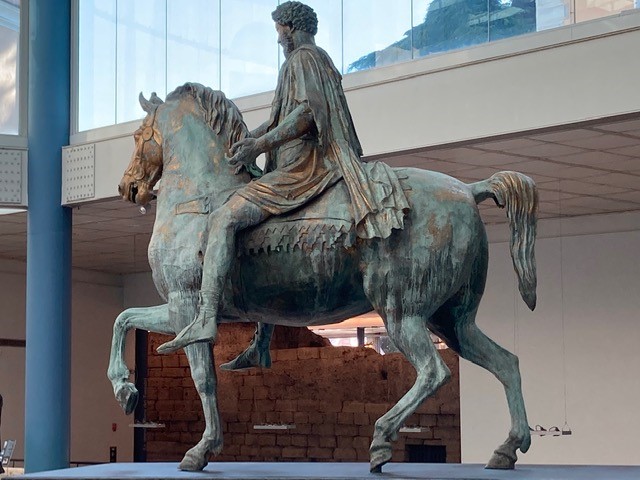 This bronze statue of Roman emperor Marcus Aurelius on horseback stands in the Capitoline Museums in Rome. It's one of many works of art featured in the TV series "Rick Steves Art of Europe." (Photo courtesy of Catherine Zurybida)
This bronze statue of Roman emperor Marcus Aurelius on horseback stands in the Capitoline Museums in Rome. It's one of many works of art featured in the TV series "Rick Steves Art of Europe." (Photo courtesy of Catherine Zurybida)
A chance email from a family friend early in the pandemic led to an interesting side project for Catherine Zurybida, an art history faculty member in DePaul's Department of History of Art and Architecture, housed in the College of Liberal Arts & Social Sciences. The project? Serving as an art history consultant for Rick Steves' newest TV show, "Art of Europe."
Steves, known across the United States for his European travel shows, books and tours, needed art historians to fact-check the "Art of Europe" scripts, and Zurybida raised her hand to help. The result was plenty of Zoom time with Steves, making sure that every art history detail of the six episodes was correct. The show, which is
streaming on public television stations nationwide, mentions her name in the closing credits.
 Catherine Zurybida is an art history lecturer in the College of Liberal Arts & Social Sciences.
Catherine Zurybida is an art history lecturer in the College of Liberal Arts & Social Sciences.
Zurybida, who specializes in Byzantine, ancient and early medieval art, has served as an adjunct lecturer at DePaul since 1990. Newsline sat down with her to discuss the opportunity, the importance of studying art history and more.
What was it like to work on "Art of Europe"?
It was fun to be part of a team and to specifically help reach people who don't necessarily know much about art history or are intimidated by it. Unlike literature, where people start reading stories when they are little, people don't usually learn about art history until college, and even then it might be a single course for a humanities requirement. This was a chance to reach a wider audience and really make the discipline feel more manageable and available for anyone.
How can a show like "Art of Europe" help someone learn more about art?
Seeing art through someone else's eyes makes you notice different things, and that's wonderful. Rick does an excellent job of taking viewers to places you can actually visit without some sort of special access. He knows what people are interested in, and he knows how to explain things to people in a way that makes it fun to learn.
Why do you believe teaching art history is so important?
The history of everything is important. The study of art history is relatively new. It really began only in the 1860s. When you study the cultural products that societies create, you begin to understand things that you didn't learn when you looked at their political history. You begin to understand their belief system, their symbolic language, a lot of which has to do with religion. Therefore, you come to understand how people see their religion, not just what they think of it or feel about it, but the pictures inside their head. So studying art history is another way of learning about people in the past.
Do you have a good example of the importance of art history?
Take ancient Egypt: Almost everything we have that survives from that society comes from a tomb and was essentially an artistic product, like sculptures and hieroglyphics carved into walls and on tablets. So, art is a way of fleshing out the little bits that we know about history in the ancient world. Art historians help create a more complete picture of history.
"Art of Europe" is available to watch for free on
Rick Steves' website.
Russell Dorn is a manager of news and integrated content in University Marketing and Communications.